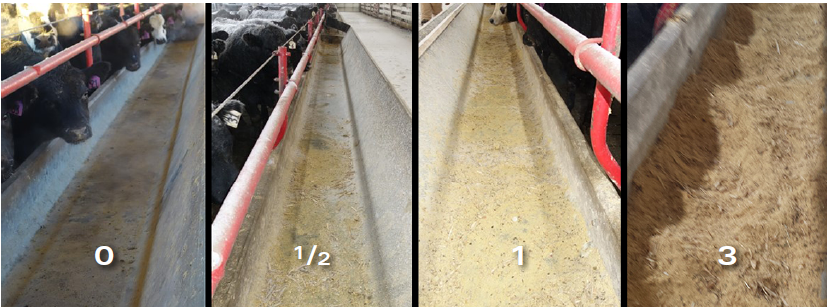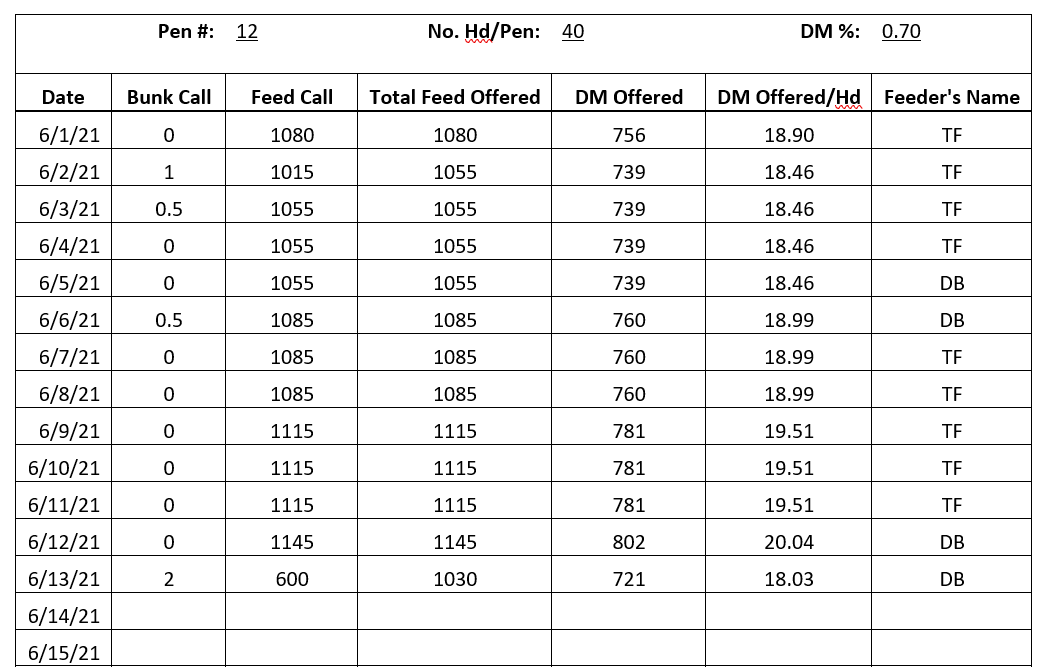Managing the feed bunk for improved cattle performance
The art of cattle feeding takes years of experience to master but understanding the science of feed bunk management can greatly shorten the learning curve.

Cattle typically exhibit a diurnal feeding pattern that is associated with photoperiod, by feeding in the early morning and again in the afternoon. The fact that cattle are creatures of habit is extremely helpful as we consider practicing feed bunk management. Bunk management can be extremely useful as we feed cattle up to peak feed intake, which may be after 30 to 50 days for yearlings and 60 to 80 days on feed for calves. However, external factors, such as weather are known to affect cattle feed intake. Cattle feed intake will fluctuate as temperatures beyond the thermoneutral zone of cattle occur, whereby feed intake decreases at extremely high temperatures and increases at extremely low temperatures. Therefore, making the correct feed calls requires skill, an awareness of cattle behavior, and an awareness for future weather events.
Bunk management refers to matching the amount of feed delivered to the amount of feed cattle can consume without causing digestive upsets. The simplest form of bunk management is to provide cattle with ad libitum feed, which means to ensure feed is always available. An excellent example of the ad libitum bunk management strategy is observed with self-feeders but can also be done with feed bunks. Although ad libitum bunk management may be the simplest way to feed cattle, it is not without its drawbacks. Ad libitum feeding wet feedstuffs, such as high-moisture corn or corn silage, is challenging to do without producing mold. Cattle also tend to sort out particular feedstuffs when high-forage diets are offered ad libitum. Additionally, cattle do not know how much they need to eat. Over-eating obviously results in the greatest daily feed intake. However, over-eating is often followed by a period of reduced feed intake caused by the inability of the rumen to clear excessive amounts of lactic acid produced during rumen fermentation. Over-eating can overwhelm the rumen microbiota causing inefficient fermentation and the onset of metabolic disorders such as bloat or ruminal acidosis.

More refined bunk management practices than simply offering ad libitum feed can prevent feed intake cyclicity and metabolic disorders caused by over-eating. One such bunk management is called ‘slick bunk’ management. Slick bunk management is the practice by which the amount of feed offered closely matches maximal feed intake of the cattle resulting in a ‘slick’ or empty feed bunk just before the next feeding time. The slick bunk management feeding strategy uses a 4-point feed bunk scoring system as shown in Table 1, with examples in Figure 1. The cattle feeder maintains a ‘bunk sheet’ that includes a date, the bunk call, the feed call, total feed amount, and the feeder’s initials for each pen of cattle fed.
Also knowing the dry matter percentage of the diet and the number of cattle per pen allows you to calculate and record the total dry matter offered and total dry matter intake per head to make knowledgeable feed calls. An example bunk sheet is shown in Figure 2. The bunk call refers to the daily bunk score for each pen. The feed call refers to the amount of feed that needs to be mixed and offered to each pen. The total amount of feed offered includes any refusal or leftover feed from the previous day, in addition to the feed call for new feed being offered.

For example, let us assume yesterday you increased the amount of feed offered to a pen to 1145 pounds and today the feed bunk score was a 2. Therefore, 1145 pounds of feed was an overestimate of what the cattle were capable of eating. A feed bunk score of 2 equates to (25 to 50% of feed remaining) approximately 430 pounds of feed remaining in the bunk. Therefore, the feed call could be 600 pounds or a total feed amount of 1030 pounds (430 pounds of leftover feed plus 600 pounds of new feed) for the day. Offering 1030 pounds of feed instead of 1145 pounds allows the cattle feeder time to work the cattle back up to maximum feed intake without creating a cyclical pattern.
In another example, let us assume for another pen you had also increased the amount of feed offered to 1145 pounds, but today the feed bunk score was a ½. A feed score of 0 or ½ would mean that the previous feed call matched well with what the cattle were capable of eating. In this case, allow cattle to remain at the same feed intake for at least three days before increasing the amount of feed delivered to that pen again. When increasing feed deliveries for cattle, try targeting 0.25 to 0.75 pound of dry matter per head to avoid making large changes in dry matter intake. Remember, cattle are creatures of habit and they like consistency. Consistency also allows time for the rumen microbes to adjust to the greater feed intakes and helps prevent digestive disorders from occurring.
Research from South Dakota State, published in the Journal of Animal Science by Prichard and Bruns, compared feeding cattle using ad libitum or slick bunk management strategies. Figure 3 illustrates the cyclic feed intake pattern of cattle with ad libitum bunk management (Lot A) and steady feed intake pattern of cattle with slick bunk management (Lot B). In this experiment, beef steers fed using ad libitum (20.2 lb./d) and slick bunk management (19.7 lb./d) had a similar average daily dry matter intake. Noticeably, steers fed using slick bunk management had a more desirable average daily gain (3.76 lb./d) and feed:gain ratio (5.35 lb./lb.) compared with steers fed using ad libitum bunk management (2.07 lb./d and 9.58 lb./lb., respectively).
In summary, the goal of using a slick bunk management strategy is to reduce feed intake variation and periods of feed intake cyclicity to promote greater and more efficient gains. To be a successful cattle feeder, one must aim to minimize feed intake variation by having an understanding and awareness of the cattle and how they respond to the environment.



 Print
Print Email
Email
